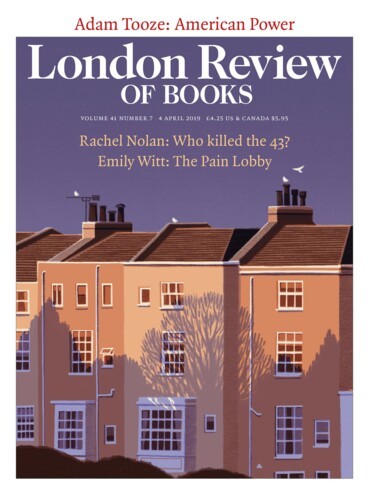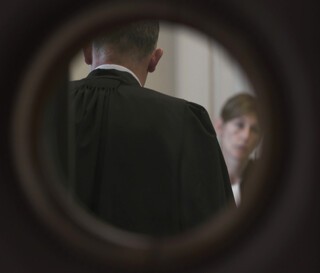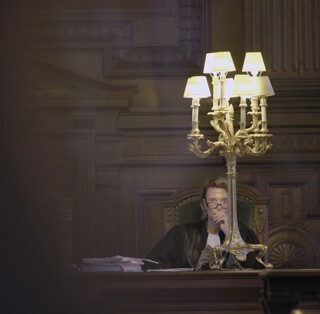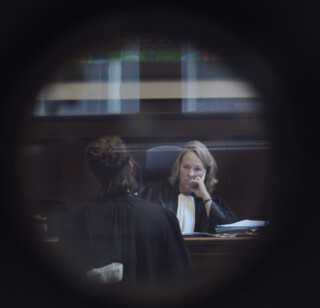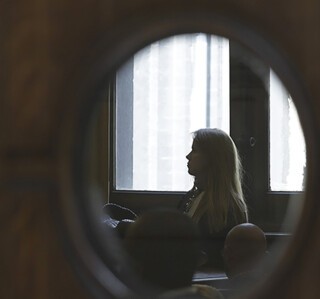The Palais de Justice in Brussels is a product of civic and architectural delirium, a Circumlocution Office looming over the historically working-class Marolles district like a sinister, secular basilica. It’s bigger than St Peter’s in Rome, covering an area of 26,000 square metres, with reputedly the largest accumulation of stone blocks in Europe. Its architect, Joseph Poelaert, inspired by John Martin’s scenes of apocalyptic ruin, had been fantasising about such a structure for years before he won the commission to design the new Palais in 1861. Time passed, costs swelled from four million to fifty million francs, Poelaert died in 1879 and four years later the city received its monumental hilltop labyrinth – ‘a colossus, inside a monster’, Paul Verlaine said. Public reaction was hostile. The building was considered an affront to Brussels – a hypertrophied analogue of Belgium’s imperial ambitions – and on the day it opened a mob invaded, tearing down statues and paintings, pissing and shitting on the marble floors.
From the start, the courtrooms, corridors and precincts of the Palais de Justice seemed also to constitute a ruinous, fantastical museum of the building itself. Its scale, and awful mix of Egyptian, Greek and Byzantine influences, recalls the architectural reveries of Piranesi; it is said that there are staircases that go nowhere, like those in his Carceri d’Invenzione. When Freud saw it two years after it was completed, he was put in mind of an Assyrian palace as drawn by Gustave Doré. Later visitors have hardly got past the bristling columns at the main entrance before thinking of Kafka: this is where Orson Welles hoped to film his adaptation of The Trial. W.G. Sebald’s Jacques Austerlitz goes wandering in the depths of the Palais looking for Masonic symbols, and finds corridors piled high with ancient office furniture, chairs and lecterns and roll-top cupboards – as if the last, lost inhabitants had barricaded themselves in.
When the artist Carey Young first began exploring the Palais, she was struck by the female judges and lawyers. She spotted five women in conference in a courtroom; they spotted her, and rushed to close the door. Young’s 18-minute video Palais de Justice, which is on show at the Towner Art Gallery in Eastbourne (until 2 June), is a meditation on authority and visibility. After her request to film in the building was denied on security grounds – a magistrate and her clerk were murdered in court in 2010 – Young decided to work surreptitiously, with the help of an assistant, a small tripod and long lenses. A Belgian lawyer advised her, if caught pointing her camera into courtrooms, to say that judges are public figures and possess no right to privacy while at the bench. The argument worked on the few security guards who tried to stop her.
Palais de Justice is projected to fill a large gallery wall at the Towner and at first it seems the work will address itself to the wild iconography and maddening dimensions of the place. A young man in T-shirt and trainers descends a monumental set of stairs, flanked by huge statues of classical orators. (Tourists often don’t progress beyond this Cecil B. DeMille scenery, exhausting themselves trying to photograph its bizarre angles and vistas.) Next we’re looking down vertiginously into the vast, gloomy lobby, or salle des pas perdus, where lawyers meet with their clients in plush alcoves. A distant porter toils across the hall, pushing a trolley full of papers. A small party of lawyers trots by laden down with overstuffed folders, like something out of a cartoon by Daumier. But Young quickly takes us past this bureaucratic comedy, into the heart of the legal process and its delicate performance.
The courtrooms of the Palais de Justice have heavy doors padded with leather and inset with round windows, and it’s through these that much of Young’s video was secretly shot. She concentrates at first on the faces and gestures of the judges – they shuffle their papers, pause with pen in midair, peer over their reading glasses at the advocates in front of them, cock their heads quizzically or stare straight ahead with what looks like unfathomable boredom but is probably strategic impassivity. They are all silent. Stuck on the other side of soundproof doors, Young gives Palais de Justice a soundtrack drawn from the muffled life of the corridor, which occasionally we see reflected in the scratched pane of a courtroom porthole.
The judges dominate much of Palais de Justice, but they slowly give way to portraits of younger women, the lawyers arguing before them. One woman appears early on, perfectly framed in profile by the little window: she looks like a study, in miniature, of rhetorical gestures, attitudes of appeal or even supplication. Her colleagues, who come later, are more fragmented – whether by the limited camera angles available to Young or her deliberate editing out of their faces. The young advocates are reduced to anonymous details: an ear, the nape of a neck, hair that rhymes with the tight pleats and loose folds of their robes. In these shots, Young’s long lens produces a tiny depth of field, sharply isolating aspects of person and dress from the blurred suggestion of courtroom panelling, distant paintings and other faceless figures. It’s as if a different gaze has intruded, voyeuristic and fixated and very likely male.
It’s the gaze, most obviously, of some cinematic precursors. All those backs of heads, with hair pinned up or loosely pulled to one side of the neck, resemble certain indelible shots in Andrei Tarkovsky’s Solaris, Chris Marker’s La Jetée and its ur-text, Hitchcock’s Vertigo. There’s a sci-fi quality to Palais de Justice: from the submarine portholes to the growing sense that the work shows a future in which women have taken over the institutions of justice, and perhaps much else (assuming, that is, anything exists outside of this huge self-involved system). The men who appear in Young’s video seem at best peripheral figures, always subject to the speech and gaze of the judges, or stranded in passageways and vestibules. One fretful advocate looks as though he has been waiting there for ever.
Young has been making art about the law for some years, and in a variety of media. Report of the Legal Subcommittee (2010) is a print of an astronomical map, accompanied by the transcript of a UN meeting to determine the legal definition of outer space. Legal Maxims (2013) consists of the phrases ‘wrong in itself’ and ‘nobody’s thing’ rendered in white neon, as if the principles of malum in se and res nullius have been translated into the rhetorical register of street advertising. Her work is frequently exercised by the language of the law, its precision, abstraction, density.
Palais de Justice comes at the subject from another direction and in a more aesthetic mood. Young has made, but not shown at the Towner, a related series of eight photographs entitled, after Kafka, Before the Law, which depicts more or less ornate courtroom doors – closed, ajar or wide open – suggesting different degrees of procedural transparency or opacity. Verlaine wrote that the Palais de Justice ‘wants to be as terrible as the Law, severe and sumptuously naked’. In Young’s video a luxurious austerity prevails, in the architecture and among her human subjects. The viewer watches them covertly but here and there a heart-stopping moment of connection seems to occur. A judge’s gaze drifts or darts towards the camera. The waiting male lawyer turns and gives the artist (and us) a hard stare. Except it’s an illusion: Young was too far away, or too well concealed, to be observed. Both she and the law are getting on with their hard work, secretly and in plain sight.
Send Letters To:
The Editor
London Review of Books,
28 Little Russell Street
London, WC1A 2HN
letters@lrb.co.uk
Please include name, address, and a telephone number.
